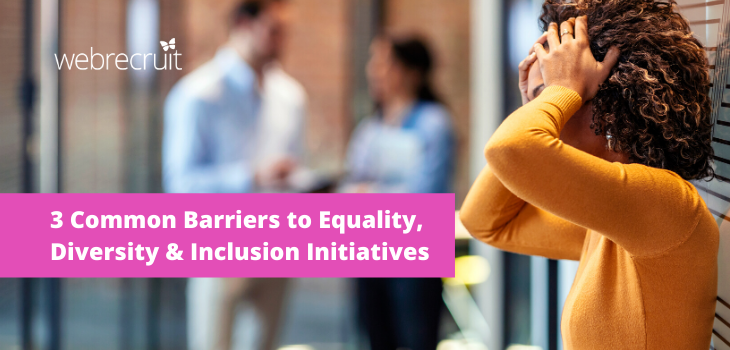Diversity is a topic of increasing importance for many organisations, as they seek to develop strategies to help them improve the inclusiveness of their workplace and reduce unconscious bias within the recruitment process.
In fact, 77% of talent professionals cite that diversity will be very important in the future of recruiting, according to LinkedIn.
However, what happens when you experience setbacks and barriers to your equality, diversity and inclusion (EDI) efforts? And more importantly, how can you overcome them?
The rollout of any strategy will always come with challenges; the main thing is to identify what they are and develop solutions to help you move past them.
What are the main barriers to equality, diversity and inclusion in the workplace?
1. Lack of budget
It can be tough to justify spend and prove return on investment (ROI) for EDI initiatives, especially if these ideas are completely new to your organisation. However, without a forecast of ROI, it can be challenging to get budget approval from senior stakeholders.
This is why it’s important to do your research and build a solid business case. Consider the potential benefits of these initiatives to your organisation. For example, a positive change to company culture can lead to improved staff retention over time, meaning that less money needs to be spent on recruiting and training new employees.
You should also consider what metrics you will track and what ‘success’ will look like to you. Some examples of key metrics recommended by Diversity Best Practices are velocity of movement within your organisation (i.e. how long it takes to hire, promote or move laterally), the percentage of diverse candidates within your talent pipeline and employee engagement scores (monitored by race and gender).
We’d recommend researching other organisations who have implemented EDI initiatives and noting not only the results they’ve achieved but also the time taken to see these results. This will give senior stakeholders real life examples of the impact of change in other companies.
2. Lack of support
If your planned EDI initiatives are going to be successful, it’s important that all employees within your organisation are engaged and fully bought-in.
You’ll likely encounter co-workers who don’t understand the emphasis you’re placing on diversity and inclusion and may express cynicism. Whatever the reasons behind their cynicism, it’s important to explain the reasons you are launching these initiatives as a business and the benefits you believe they will bring.
Communication is key when it comes to rolling out any new initiatives in the workplace. Once your co-workers understand there’s a reason behind these initiatives and they’re not just a ‘box ticking’ exercise (as some might perceive), they’re more likely to get on board with them.
3. Lack of tools
You might have planned the metrics you’re going to track but you also need to plan how you will track them.
Reporting on your efforts is vital in order to justify your investment and show the impact of your efforts. This is why you should consider using technology that allows you to report on your diversity initiatives with ease.
For example, Webrecruit ATS includes equal opportunities reports and blind hiring functionality, allowing you to anonymise applications to reduce unconscious bias in the recruitment process.
If you’re able to tap into budget for your EDI efforts, allocating a portion towards HR or recruitment software with EDI functionality would be a very good choice.
Are you in the process of developing an EDI strategy? Find out more about Webrecruit’s EDI solutions and how we can partner with your organisation by clicking the button below.






